AH-TAH-THI-KI Museum - 2011
Big Cypress Seminole Reservation
Updated: 06/16/11
The AH-TAH-THI-KI Museum provides a large amount of information about south Florida and the Seminole Tribe of Florida. It is located in the center of the town section of the the Big Cypress Seminole Reservation. The galleries showcase rare artifacts and life-size depictions of traditional Seminole practices in 1890's Florida.
The layout of this page gives a summary of the information
next to the thumbnail image of the panel.
If you want more information than
what is provided, click on the thumbnail photograph and read the entire panel. A
common thread on the panels is the Seminole successful change to commercial
ventures.
Our
first experience was in the theatre for a five screen film and a presentation by
a docent. He gave us some information on the structure of the tribe to help us
better understand the movie.
We visited the theatre twice - our first experience and our last at the museum. We did not have an presenter the second time.
After Florida became a state in 1812, conflicts increased due to the treaty of Moultrie Creek and The Indian Removal Act. During the Seminole Wars almost 4,500 Seminoles were killed or relocated to Oklahoma. The Seminole Tribe of Florida call themselves " The Unconquered". They are the decedents of just 300 who managed to elude capture by the US army in the 19 century. This small population of Seminoles made a living as cattlemen, hunters, guides and early tourism operators. Today, they have their own government, laws, police and services, just like a small country. However, they are US citizens and must obey American laws.
From
Surviving to Thriving: An Everglades Economy is a chronological look at how the
Everglades has sustained the Seminoles from the mid-1800s to the present.
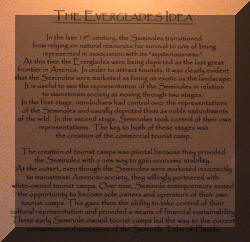 The
Everglades Idea . . . In the late 19th century, the Seminoles transitioned from
relying on natural resources for survival to one of being associated with the
last American frontier. They moved from isolation to commercial successes.
The
Everglades Idea . . . In the late 19th century, the Seminoles transitioned from
relying on natural resources for survival to one of being associated with the
last American frontier. They moved from isolation to commercial successes.
The
Seminoles used their knowledge of the Everglades to transport natural goods they
harvested to trading posts throughout the southern half of Florida.
By
1902, dredging companies had begun to drain the Everglades. Lowering of the
water table made it difficult to continue their life style of canoeing to
locations for trade. With
the railroad running south to Miami, arriving settlers, tourists and investors
forced changes to traditional Seminole lifestyles.
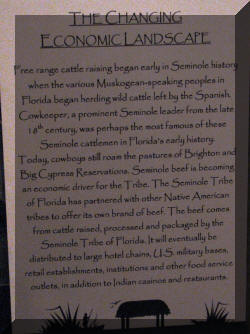 Starting
with free range cattle left by the Spanish, the Seminoles developed a beef
business delivering to hotels and other retail outlets in Florida. Today they
have expanded their business interested to also include casinos, bingo parlors
and other tourism related endeavors.
Starting
with free range cattle left by the Spanish, the Seminoles developed a beef
business delivering to hotels and other retail outlets in Florida. Today they
have expanded their business interested to also include casinos, bingo parlors
and other tourism related endeavors.
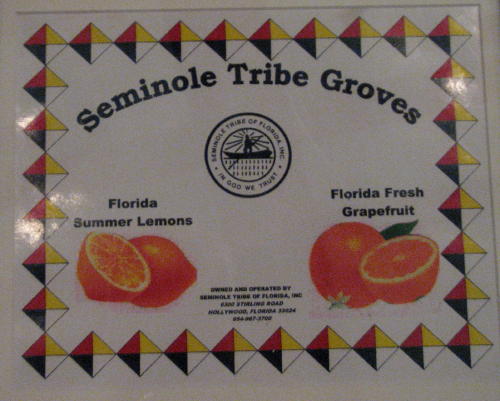
Other businesses were established to sell products.
Visitors
to the museum will understand how the Seminoles reliance on the Everglades has
shifted from one of natural resource utilization for survival to marketing the
Everglades idea.
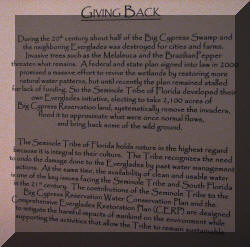 During the 20th century about half of the Big Cypress Swamp and the
neighboring Everglades were destroyed for cities and farms. Because the federal
and state plans to revive wetlands signed into law in 2000 did not move forward due to a lack of
funding, the Seminoles established their own initiatives to restore some of
their own land to the wild ground they once knew.
During the 20th century about half of the Big Cypress Swamp and the
neighboring Everglades were destroyed for cities and farms. Because the federal
and state plans to revive wetlands signed into law in 2000 did not move forward due to a lack of
funding, the Seminoles established their own initiatives to restore some of
their own land to the wild ground they once knew.
Notice
the beautiful colors in the clothing. The tribe is famous for their colorful
patchwork clothing. There is a cottage industry creating patchwork clothing
items for sale to tourists.
Diorama's showed the historical life style of the Seminole tribe. Panels described elements of their lives.
Some panels included quotes from Tribal Members regarding eating habits and manners . . .
This
diorama shows the dugout canoe used for trading throughout the Everglades. The
Seminoles actually 'dug out' their canoes. The did not burn out the log but used
tools to remove wood from the log.
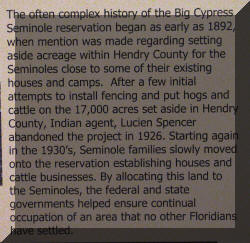 The often complex history of the Big Cypress Seminole reservation began in
1892. The land allocated to the Seminoles was in an area no other Floridians had
settled.
The often complex history of the Big Cypress Seminole reservation began in
1892. The land allocated to the Seminoles was in an area no other Floridians had
settled.
Big Cypress includes pinelands, Everglades marsh and cypress prairie. Today, Big Cypress is the largest Seminole reservation with all the services of a city for its 592 residents. The tribe has six reservations in Florida. In addition to Big Cypress they have reservations in Hollywood, Brighton, Immokalee, Ft. Pierce and Tampa.
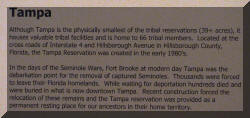 The
Tampa Reservation is the smallest reservation with only 66 tribal members on 39
acres.
The
Tampa Reservation is the smallest reservation with only 66 tribal members on 39
acres.
Today, the Hollywood reservation includes almost 500 acres. It is the administrative headquarters for the entire tribe. Its location on Florida's Gold Coast offers many commercial opportunities. The very popular Seminole Hard Rock Casino is located there.
Word of mouth was used to pass the legends
from generation
to generation.
Interactive activities for children and adults were included in the exhibits of the museum.

A
pair of Leg Rattles. made from turtle shells with leather backing - filled
with beads and seeds.
A raised boardwalk winds through a natural cypress dome and leads to an authentic Living Village. An abundance of birds, swamp vegetation and an occasional swamp animal are boardwalk highlights.
Along
the way information boards highlight parts of nature used by the tribe. The
various trees, shrubs and plants are identified also.
Spanish Moss . . . description and uses.
Resurrection Fern . . . description and uses . . .
At a junction on the boardwalk you could choose between going to the village or to the conservation laboratory. It was very hot the day we visited. Mary Lou decided to go to the conservation laboratory. She walked far enough on the boardwalk to get the experience of walking in the cypress dome before returning to the air conditioned museum.
The conservation laboratory is responsible for all cleaning, sorting, documentation, study and long term storage of the artifacts found in the area.
The tribe's staff of archeologists use excavation to acquire more data. For every hour an archeologist spends in the field, three hours are spent in the lab processing the artifacts.
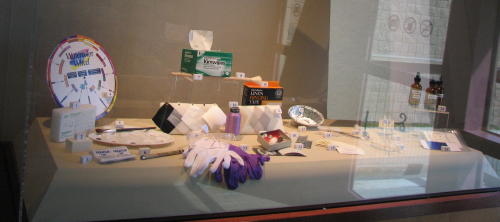
This display case shows some of the tool of the archeologists.
The Seminole Tribe of Florida's Tribal Historic Preservation Office is responsible for all archeological and historical resource surveys. Their results allow the tribe to make its own decisions on preserving and presenting their heritage.
Over the doorways . . .
Admission was $6 adults, senior and military discounts available. Allow about three hours if you read all the informational panels. We found our visit to the AH-TAH-THI-Ki museum worthwhile.
If you are interested in additional information regarding the Seminole tribe, we suggest two web-sites: www.flheritage.com/facts/history/seminole/ or www.bigorrin.org/seminole_kids .
MAIN PAGE - Florida Winter Tour - 2011